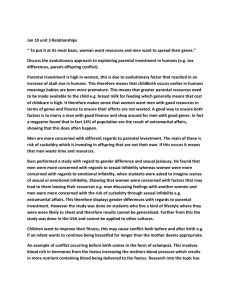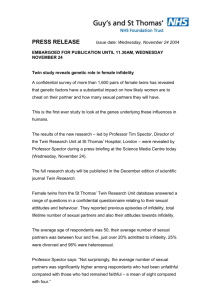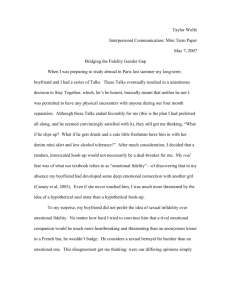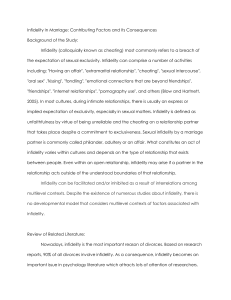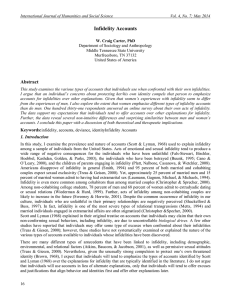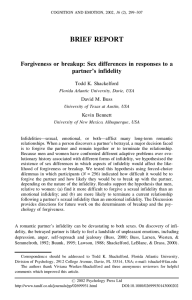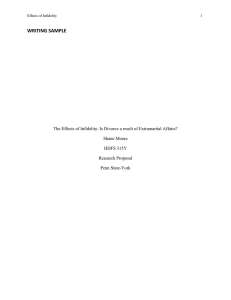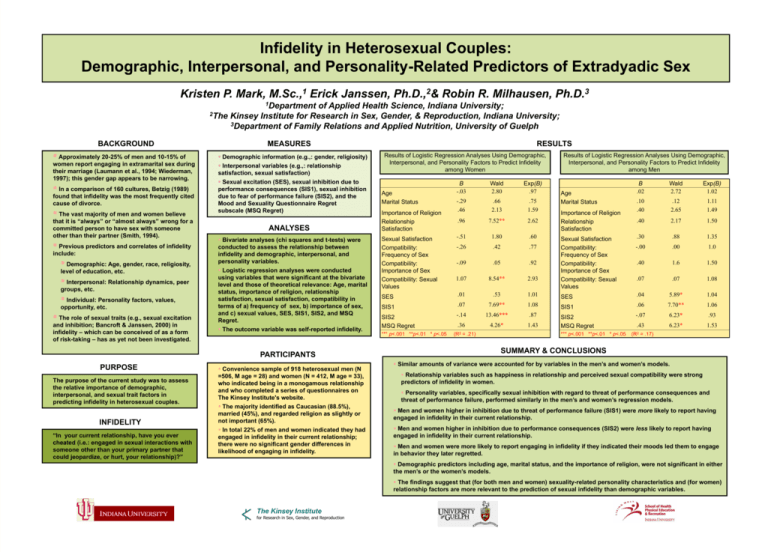
Infidelity in Heterosexual Couples:
Demographic, Interpersonal, and Personality-Related Predictors of Extradyadic Sex
Kristen P. Mark,
1
M.Sc.,
2
Ph.D., &
Erick Janssen,
Robin R. Milhausen,
3
Ph.D.
1Department
of Applied Health Science, Indiana University;
2The Kinsey Institute for Research in Sex, Gender, & Reproduction, Indiana University;
3Department of Family Relations and Applied Nutrition, University of Guelph
BACKGROUND
MEASURES
Approximately 20-25% of men and 10-15% of
Demographic information (e.g.,: gender, religiosity)
women report engaging in extramarital sex during
their marriage (Laumann et al., 1994; Wiederman,
1997); this gender gap appears to be narrowing.
Interpersonal variables (e.g.,: relationship
satisfaction, sexual satisfaction)
In a comparison of 160 cultures, Betzig (1989)
found that infidelity was the most frequently cited
cause of divorce.
The vast majority of men and women believe
that it is “always” or “almost always” wrong for a
committed person to have sex with someone
other than their partner (Smith, 1994).
Previous predictors and correlates of infidelity
include:
Demographic: Age, gender, race, religiosity,
level of education, etc.
Interpersonal: Relationship dynamics, peer
groups, etc.
Individual: Personality factors, values,
opportunity, etc.
The role of sexual traits (e.g., sexual excitation
and inhibition; Bancroft & Janssen, 2000) in
infidelity – which can be conceived of as a form
of risk-taking – has as yet not been investigated.
Sexual excitation (SES), sexual inhibition due to
performance consequences (SIS1), sexual inhibition
due to fear of performance failure (SIS2), and the
Mood and Sexuality Questionnaire Regret
subscale (MSQ Regret)
ANALYSES
Bivariate analyses (chi squares and t-tests) were
conducted to assess the relationship between
infidelity and demographic, interpersonal, and
personality variables.
Logistic regression analyses were conducted
using variables that were significant at the bivariate
level and those of theoretical relevance: Age, marital
status, importance of religion, relationship
satisfaction, sexual satisfaction, compatibility in
terms of a) frequency of sex, b) importance of sex,
and c) sexual values, SES, SIS1, SIS2, and MSQ
Regret.
The outcome variable was self-reported infidelity.
PARTICIPANTS
PURPOSE
The purpose of the current study was to assess
the relative importance of demographic,
interpersonal, and sexual trait factors in
predicting infidelity in heterosexual couples.
INFIDELITY
“In your current relationship, have you ever
cheated (i.e.: engaged in sexual interactions with
someone other than your primary partner that
could jeopardize, or hurt, your relationship)?”
Convenience sample of 918 heterosexual men (N
=506, M age = 28) and women (N = 412, M age = 33),
who indicated being in a monogamous relationship
and who completed a series of questionnaires on
The Kinsey Institute's website.
The majority identified as Caucasian (88.5%),
married (45%), and regarded religion as slightly or
not important (65%).
In total 22% of men and women indicated they had
engaged in infidelity in their current relationship;
there were no significant gender differences in
likelihood of engaging in infidelity.
RESULTS
Results of Logistic Regression Analyses Using Demographic,
Interpersonal, and Personality Factors to Predict Infidelity
among Women
B
-.03
Wald
2.80
Exp(B)
.97
-.29
.46
.66
2.13
.75
1.59
.96
7.52**
2.62
-.51
1.80
.60
-.26
.42
.77
-.09
.05
.92
1.07
8.54**
2.93
SES
.01
.53
1.01
SIS1
.07
7.69**
SIS2
MSQ Regret
-.14
.36
Age
Marital Status
Importance of Religion
Relationship
Satisfaction
Sexual Satisfaction
Compatibility:
Frequency of Sex
Compatibility:
Importance of Sex
Compatibility: Sexual
Values
*** p<.001 **p<.01 * p<.05
(R2 = .21)
Results of Logistic Regression Analyses Using Demographic,
Interpersonal, and Personality Factors to Predict Infidelity
among Men
B
.02
Wald
2.72
Exp(B)
1.02
.10
.40
.12
2.65
1.11
1.49
.40
2.17
1.50
.30
.88
1.35
-.00
.00
1.0
.40
1.6
1.50
.07
.07
1.08
SES
.04
5.89*
1.04
1.08
SIS1
.06
7.70**
1.06
13.46***
.87
-.07
6.23*
.93
4.26*
1.43
SIS2
MSQ Regret
.43
6.23*
1.53
Age
Marital Status
Importance of Religion
Relationship
Satisfaction
Sexual Satisfaction
Compatibility:
Frequency of Sex
Compatibility:
Importance of Sex
Compatibility: Sexual
Values
*** p<.001 **p<.01 * p<.05
(R2 = .17)
SUMMARY & CONCLUSIONS
Similar amounts of variance were accounted for by variables in the men’s and women’s models.
Relationship variables such as happiness in relationship and perceived sexual compatibility were strong
predictors of infidelity in women.
Personality variables, specifically sexual inhibition with regard to threat of performance consequences and
threat of performance failure, performed similarly in the men’s and women’s regression models.
Men and women higher in inhibition due to threat of performance failure (SIS1) were more likely to report having
engaged in infidelity in their current relationship.
Men and women higher in inhibition due to performance consequences (SIS2) were less likely to report having
engaged in infidelity in their current relationship.
Men and women were more likely to report engaging in infidelity if they indicated their moods led them to engage
in behavior they later regretted.
Demographic predictors including age, marital status, and the importance of religion, were not significant in either
the men’s or the women’s models.
The findings suggest that (for both men and women) sexuality-related personality characteristics and (for women)
relationship factors are more relevant to the prediction of sexual infidelity than demographic variables.
The Kinsey Institute
for Research in Sex, Gender, and Reproduction

